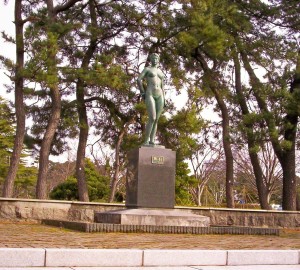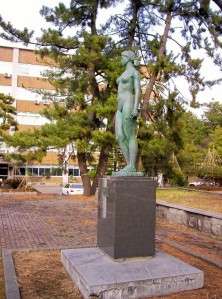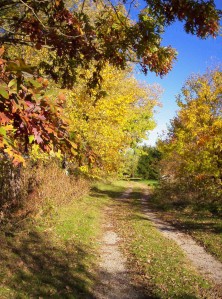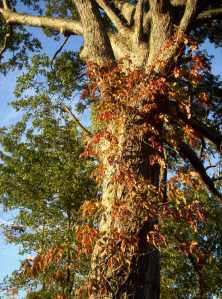 Dragonfly was conceived and written on two continents, on opposite sides of the world. Come along with me on the official fan tour of historic locations relating to the book! What you’re looking at here is one of two “Birthplaces of Dragonfly.” This is the one that’s easier to get to if you live in Japan. This little grove of trees is in front of the Humanities building at Niigata University’s Ikarashi campus. As the story goes, I had come to the university that day with two friends who were attending a special seminar on how to make kimchee. This is so far in the dim past now that I don’t remember why I tagged along, since I had not intended to go to the kimchee session. While my two friends were indoors learning how to bury cabbage and spices with the full intention of digging them up again, I was wandering around in the location you see, and the ideas for the book began to flood over me. It started, as I recall, with the two names Dragonfly and Mothkin. I glimpsed in my head something like a cutaway diagram of cellars or levels descending into the Earth. I knew Dragonfly was a girl who was going to journey down and down into a place that would be peopled with werewolves, vampires, and other Hallowe’en boogey-folk.
Dragonfly was conceived and written on two continents, on opposite sides of the world. Come along with me on the official fan tour of historic locations relating to the book! What you’re looking at here is one of two “Birthplaces of Dragonfly.” This is the one that’s easier to get to if you live in Japan. This little grove of trees is in front of the Humanities building at Niigata University’s Ikarashi campus. As the story goes, I had come to the university that day with two friends who were attending a special seminar on how to make kimchee. This is so far in the dim past now that I don’t remember why I tagged along, since I had not intended to go to the kimchee session. While my two friends were indoors learning how to bury cabbage and spices with the full intention of digging them up again, I was wandering around in the location you see, and the ideas for the book began to flood over me. It started, as I recall, with the two names Dragonfly and Mothkin. I glimpsed in my head something like a cutaway diagram of cellars or levels descending into the Earth. I knew Dragonfly was a girl who was going to journey down and down into a place that would be peopled with werewolves, vampires, and other Hallowe’en boogey-folk.
An early idea that I later discarded was that Dragonfly would spend much of her life in Harvest Moon — that she would live, have a job, marry, and have children there. I imagined her pulling a cart with onions to sell. The phrase “Onion Years” swirled around in my mind. In the finished book, Dragonfly does get into a bit of agricultural commerce with Sylva, but she doesn’t become the mother of a new generation of werewolves. (If they had had a child, what would they have named the little one? Maybe “Glamis” after Grandpa Cawdor, in keeping with the Macbeth theme? Or perhaps it would have been twins, Mac and Beth?)
that she would live, have a job, marry, and have children there. I imagined her pulling a cart with onions to sell. The phrase “Onion Years” swirled around in my mind. In the finished book, Dragonfly does get into a bit of agricultural commerce with Sylva, but she doesn’t become the mother of a new generation of werewolves. (If they had had a child, what would they have named the little one? Maybe “Glamis” after Grandpa Cawdor, in keeping with the Macbeth theme? Or perhaps it would have been twins, Mac and Beth?)
What follows here are some views of fall in the place I grew up. This is what autumn looked like to me as a child. So this is the other half of the tour: the sights and settings that colored the (overabundant) descriptions in Dragonfly. I loved the fall — not as much as summer, but I loved it — and Hallowe’en was its crowning glory. I’d already be thinking of costumes in July or August. I’d figure out what I wanted to dress up as. It was usually something from whatever book I was reading: a Skull-Bearer from The Sword of Shannara, Gandalf, C-3PO, the shark from Jaws (those are all real examples). . . . Mom and Dad would lend their grownup engineering expertise. Dad would build  things like Skull-Bearer wings, and Mom would open the trove of ancient family clothing and props. She also knew how to shop the Goodwill and Salvation Army stores for excellent costume raw materials–such as the Styrofoam dinosaur head that I wore in one Hallowe’en parade, or the shaggy fur coat that, when snipped and re-stitched in the right places, became a wondrous full-body gorilla suit for my gradeschool-sized body. Dressed as the gorilla, I emerged from the darkness near Memorial School where people were lining up for the annual parade, and I remember some kids reacting with a bit of genuine fear.
things like Skull-Bearer wings, and Mom would open the trove of ancient family clothing and props. She also knew how to shop the Goodwill and Salvation Army stores for excellent costume raw materials–such as the Styrofoam dinosaur head that I wore in one Hallowe’en parade, or the shaggy fur coat that, when snipped and re-stitched in the right places, became a wondrous full-body gorilla suit for my gradeschool-sized body. Dressed as the gorilla, I emerged from the darkness near Memorial School where people were lining up for the annual parade, and I remember some kids reacting with a bit of genuine fear.
What a wonderful holiday! The parade is a long tradition in our hometown, going back well before my time. When I was little, one family heirloom was a hideous rubber crone mask — wrinkled brow, melancholy eyes, cucumberish nose, jutting warty chin, etc. My maternal grandmother used it once to freak out her husband. He was a Taylorville policeman. On the night of the Hallowe’en parade, he was directing traffic at the parade lineup. His wife, my grandma, approached him in full costume, wearing the mask (which apparently he didn’t know about), and proceeded to “get fresh” with him–patting his face, being very clingy, etc. I smile to picture this proper, serious policeman (in the black-and-white photo I’ve seen of him, he wears his uniform, a pair of glasses with tiny round frames, and a Hitler moustache) beginning to squirm as his unknown “assailant” begins to cross the line from holiday merriment into “This-is-most-irregular.”
 I could never stop with just one costume for the Hallowe’en season. I’d develop at least two: one for trick-or-treating and one for the school party. (Sometimes there’d be a third for the parade.) Although I knew full well the costumes I’d be making would be cooler than anything “off the rack,” I could never resist ogling the bright, simple suits that a lot of kids bought last-minute at the stores downtown. (People bought things downtown in those days, from the stores all around the town Square. This was long before we had a Wal-Mart.) You know those costumes, I’m sure: the face-masks secured by an elastic string around the head, the garish two-piece attire whose designs and colors don’t even try to simulate what the character is supposed to look like. For example, Frankenstein’s monster–instead of wearing ragged, mismatched, stolen clothing, the dime-store monster wears a shiny yellow shirt with his own menacing portrait on the chest, and scary-letters proclaiming him “FRANKENSTEIN!”
I could never stop with just one costume for the Hallowe’en season. I’d develop at least two: one for trick-or-treating and one for the school party. (Sometimes there’d be a third for the parade.) Although I knew full well the costumes I’d be making would be cooler than anything “off the rack,” I could never resist ogling the bright, simple suits that a lot of kids bought last-minute at the stores downtown. (People bought things downtown in those days, from the stores all around the town Square. This was long before we had a Wal-Mart.) You know those costumes, I’m sure: the face-masks secured by an elastic string around the head, the garish two-piece attire whose designs and colors don’t even try to simulate what the character is supposed to look like. For example, Frankenstein’s monster–instead of wearing ragged, mismatched, stolen clothing, the dime-store monster wears a shiny yellow shirt with his own menacing portrait on the chest, and scary-letters proclaiming him “FRANKENSTEIN!”
Well, I’d generally beg my mom to buy me one of those. If my cousin was visiting, he’d ask for one, too. Mom never indulged us in this request. She’d say, “No. You don’t want one of those sleazy costumes. We’ll make a better one.” Kids, of course, are always on the lookout for the proper names of things; I latched onto the term “sleazy costumes” and assumed it was the proper name for that type of dime-store costume . . . perhaps even a brand name. My mom often told the story of how my cousin and I ran after her along the bustling sidewalks of our town, both of us wailing, “I WANT A SLEAZY HALLOWE’EN COSTUME!” (We never got them. We ended up with not-at-all-sleazy costumes.)
Anyway, I wrote the first 80 or so pages of Dragonfly in Japan on my Ricoh N-10 word processor, a  machine about the size and weight of a microwave oven. Most of the rest, as I recall, was written in Taylorville that summer, some at our dining room table, some at my aunt’s house, and some outdoors on a card table set up just behind “the cave,” the root cellar/storm shelter you see pictured here. (That may have been the year I bought the 75-foot extension cord to enable me to write outdoors. All through my twenties, I loved the idea of writing out in the open air, in the wondrous lights of nature — the golden sunlight, the purple shade, the green glow of leaves.)
machine about the size and weight of a microwave oven. Most of the rest, as I recall, was written in Taylorville that summer, some at our dining room table, some at my aunt’s house, and some outdoors on a card table set up just behind “the cave,” the root cellar/storm shelter you see pictured here. (That may have been the year I bought the 75-foot extension cord to enable me to write outdoors. All through my twenties, I loved the idea of writing out in the open air, in the wondrous lights of nature — the golden sunlight, the purple shade, the green glow of leaves.)
Here’s the General Education building at Niigata University as it appears today. This is where I do most of my teaching and a fair amount of my writing-related thinking.
my teaching and a fair amount of my writing-related thinking.
Naming (especially in fantasy) is fun. To this day, I’m still struck at odd times with names for Untoward pairs and wish I’d used them in the book. I honestly don’t know why Dragonfly (the character) has that nickname. I liked “Mothkin” because of its suggestion of someone “kin” to the fluttering moths of the summer night, winging out of the black to beat against the screens or cling there. It seemed a good image for a dark, streetwise Agent of the Peaceable Kingdom as Mothkin is. Angels, I thought as a kid, shouldn’t all be dressed in pristine white with never a hair out of place. And in church Christmas plays, they shouldn’t be portrayed by the blonde girl. I always wanted to cast an angel to look more like a veteran prize fighter, more like a pirate. Finally with Mothkin, I got my chance.
“Sam Hain,” of course, is a sort of joke based on “Samhain,” the Celtic Lord of the Dead. (I know that the Celtic name isn’t pronounced like “Sam Hain” looks. But Hain himself wouldn’t be above adopting such a name as a pun of his own, so I think it’s justifiable.)
Uncle Henry was based on a character of the same name, appearance, and profession in my first real short story as a legal-aged writer, a piece called “Maybe Tonight” (which makes a good performance piece to be read aloud on Hallowe’en night). But it later occurred to me that Dorothy in The Wizard of Oz also had an Uncle Henry. I don’t think it was a conscious homage. It’s more a tribute to the first name of one of my two favorite college professors. Uncle Henry’s appearance is based on the psychologist who evaluated me for the Volunteer Youth Ministry program to determine if I was fit for living overseas in a foreign culture.
 Sylva’s name, of course, is meant to evoke woodlands and wildness. Eagerly Meagerly — well, my idea there is the juxtaposition of eagerness — to the point of being ravenous and rabid — with meagerness, a state of inadequacy or lack. If you think of a skeletal ghoul tormented by an insatiable hunger, you’ll have pretty much the picture I intended. Mr. Snicker: the double meaning of “laughing” and the onomatopoeic closing of a pair of scissors — he’s “one who snicks.”
Sylva’s name, of course, is meant to evoke woodlands and wildness. Eagerly Meagerly — well, my idea there is the juxtaposition of eagerness — to the point of being ravenous and rabid — with meagerness, a state of inadequacy or lack. If you think of a skeletal ghoul tormented by an insatiable hunger, you’ll have pretty much the picture I intended. Mr. Snicker: the double meaning of “laughing” and the onomatopoeic closing of a pair of scissors — he’s “one who snicks.”
“Noyes” is another of my favorite names in the book. It struck me as perfect for a vampire. First, it sounds like “Noise,” and he is a whiny, verbose character. Second, it’s a combination of “No” and “Yes,” which seems right for one who is undead–both dead and yet animate.
The two biggest influences on Dragonfly? I’d say Bradbury’s Something Wicked This Way Comes and Peter S. Beagle’s The Last Unicorn — particularly the part about the Midnight Carnival.
Until next time!
Leave a Reply